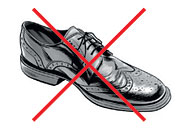The Transportation Security Administration is for many Americans their most direct point of contact with the post-9/11 national-security state. TSA policy is built on the presumption that the public won’t tolerate any risk, which is why the agency goes to great lengths to stop the terrorist threat at the familiar points — cockpit doors have been reinforced, checked baggage is now scanned, and there’s real-time updating of terrorist watch-lists.
But the agency has evolved like one of those creatures in Spore [A1]. Every time a bit of intel chatter picks up some new strategy to thwart the system, the system adapts, trying to neutralize the latest fear, which often has the side effect of making passengers more anxious. After shoe bomber Richard Reid, we padded through checkpoints in socks. If in 2003 you were a sufferer of obstructive sleep apnea, you were required to present your CPAP machine for inspection. Thanks to the TSA body scanners and offended passenger John Tyner, junk is now an acceptable public word for genitalia. And there is no real consensus that those machines, or the less exhibitionistic ones introduced this summer, can detect hidden explosives or nonmetallic weapons with enough accuracy to be worth the cost and expense.
The lines themselves are a problem, too: The longer the queue of people waiting to be screened, the easier it would be for a terrorist to detonate an explosive outside the checkpoint. That’s one reason so many airports have convoluted screening areas where rope-lines lead into far corners of the departure hall, vastly increasing the footprint of the security checkpoint while reducing the concentration of people at a particular place and time.
The TSA is also now training officers in behavioral profiling, which means that the officers are going to be even more vigilant about carefully screening people who seem stressed at the checkpoint. That’s basically everyone.
Marc Ambinder, the White House correspondent for National Journal, writes frequently about intelligence and national security.
.
The New Rules
September 12, 2001: All knives banned. Other forbidden items include disposable razors and manicure sets.
October 2001: Laptops must be X-rayed separately.

December 2001: Shoes off.
March 2005: Lighters prohibited.
September 2006: Liquid ban relaxed: three ounces or less.
August 2007: Lighters allowed.
August 2006: Liquids banned.
March 2010: Full-body scans.
August 2011: A new body-scanmachine, which produces a cartoonish, non‑gender-specificimage, debuts.
Illustrations by Martin Ansin